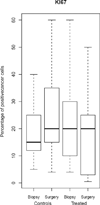Differentially expressed genes in window trials are influenced by the wound-healing process: lessons learned from a pilot study with anastrozole
- PMID: 21777924
- PMCID: PMC4509686
- DOI: 10.1016/j.jss.2011.05.058
Differentially expressed genes in window trials are influenced by the wound-healing process: lessons learned from a pilot study with anastrozole
Abstract
Background: Perioperative window trials provide an opportunity to obtain intact tumor samples at two different time-points for evaluation of potential surrogate biomarkers. We report results of a pilot trial designed to determine if treatment-mediated changes in gene expression can be detected in formalin-fixed paraffin-embedded (FFPE) samples after 10-d exposure to anastrozole in estrogen receptor (ER)-positive breast cancer compared with untreated controls.
Methods: Paired tumor samples (biopsy, surgical) were obtained from 26 postmenopausal women with ER-positive breast cancer. Patients were assigned anastrozole (1 mg/d) for 10 d immediately prior to surgery (13 cases) or no treatment (13 controls). Five hundred two cancer-related genes were examined by the Illumina cDNA-mediated annealing, selection, extension, and ligation, FFPE cDNA array (moderated t-test, P ≤ 0.005). Surrogate biomarkers reflecting changes in gene expression were examined by immunohistochemistry (Wilcoxon rank-based test, P < 0.05).
Results: Sufficient RNA was available from 19 paired samples (8 controls, 11 cases). Frozen tissue and FFPE showed good correlation (r = 0.82). Within each group, 18 genes, reflecting roles in proliferation, angiogenesis, and apoptosis, showed differential expression from biopsy to surgery (P < 0.005). Estrogen-related genes were dysregulated in the treated group only. A reduction in Ki-67 was observed in 7 (54%) treated cases and in 1 (7.7%) control patient.
Conclusions: 10-d exposure to anastrozole resulted in dysregulation of 18/502 cancer-related genes, and Ki-67 was reduced in 54% of cases. FFPE samples demonstrated good correlation with frozen samples. However, changes in gene expression and increased Ki-67 in the control group suggest local effects of wound healing may represent a confounding factor in the interpretation of perioperative window trials.
Copyright © 2012 Elsevier Inc. All rights reserved.
Figures











References
-
- Effects of chemotherapy and hormonal therapy for early breast cancer on recurrence and 15-year survival: an overview of the randomised trials. Lancet. 2005;365:1687–1717. - PubMed
-
- Chang JC, Makris A, Gutierrez MC, Hilsenbeck SG, Hackett JR, Jeong J, Liu ML, Baker J, Clark-Langone K, Baehner FL, Sexton K, Mohsin S, Gray T, Alvarez L, Chamness GC, Osborne CK, Shak S. Gene expression patterns in formalin-fixed, paraffin-embedded core biopsies predict docetaxel chemosensitivity in breast cancer patients. Breast Cancer Res Treat. 2008;108:233–240. - PubMed
-
- Paik S, Shak S, Tang G, Kim C, Baker J, Cronin M, Baehner FL, Walker MG, Watson D, Park T, Hiller W, Fisher ER, Wickerham DL, Bryant J, Wolmark N. A multigene assay to predict recurrence of tamoxifen-treated, node-negative breast cancer. N Engl J Med. 2004;351:2817–2826. - PubMed
-
- Dixon M. A study looking at the changes in the breast cancer of postmenopausal women having hormone therapy (Primary Endocrine Response Study) Edinburgh: 2011.
-
- Smith I. A trial of a short course of hormone therapy before and after surgery for early breast cancer (POETIC) Multiple cities, UK: 2011.
Publication types
MeSH terms
Substances
Grants and funding
LinkOut - more resources
Full Text Sources
Medical
Molecular Biology Databases

